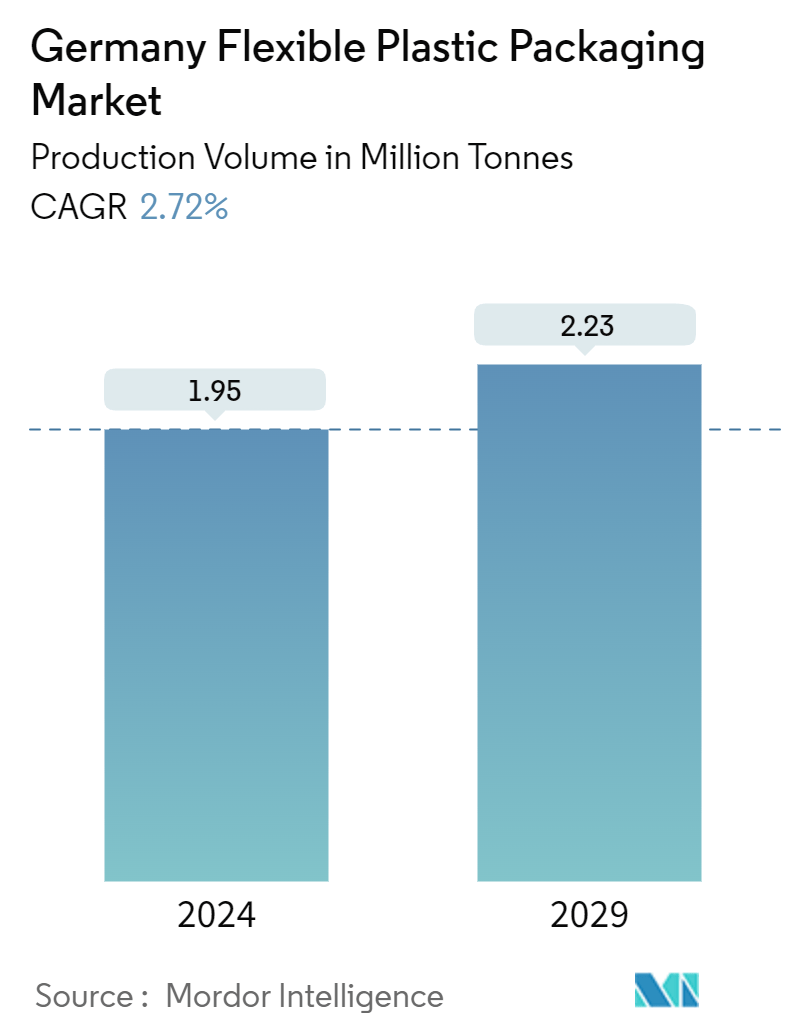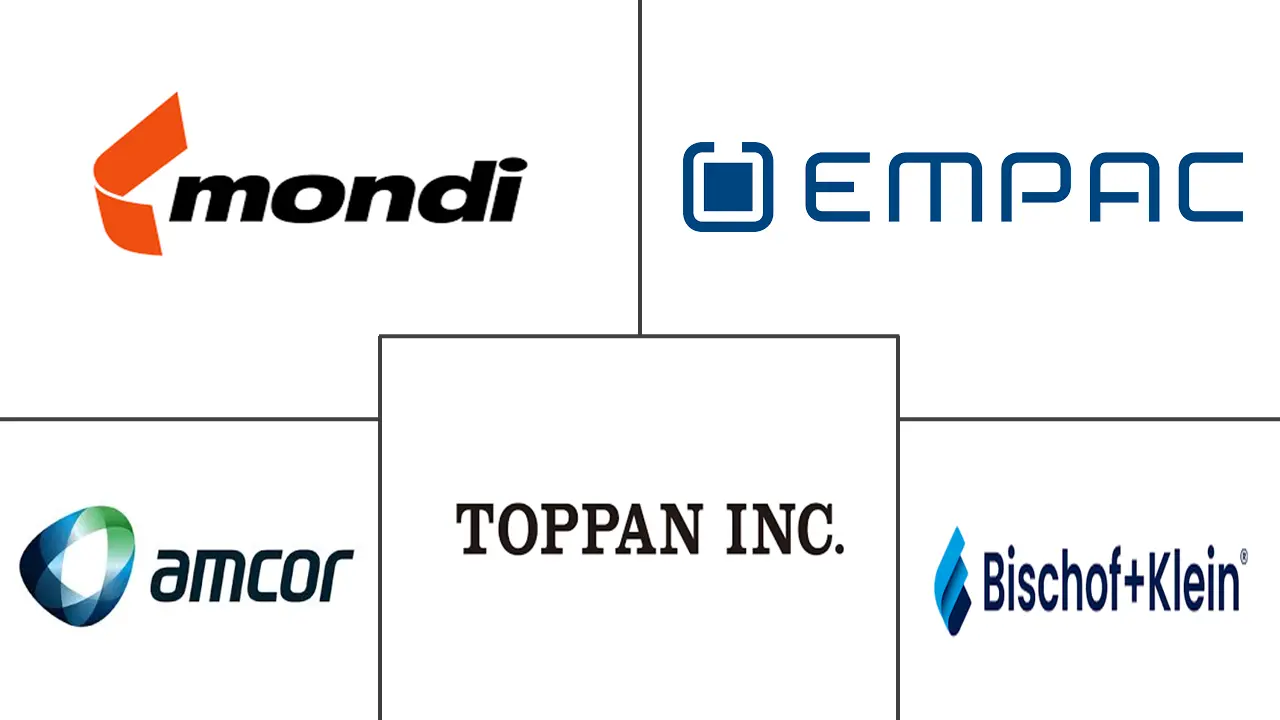Market Size of Germany Flexible Plastic Packaging Industry

| Study Period | 2019 - 2029 |
| Base Year For Estimation | 2023 |
| Forecast Data Period | 2024 - 2029 |
| Historical Data Period | 2019 - 2022 |
| CAGR (2024 - 2029) | 2.72 % |
| Market Concentration | Low |
Major Players
*Disclaimer: Major Players sorted in no particular order |
Germany Flexible Plastic Packaging Market Analysis
The Germany Flexible Plastic Packaging Market size in terms of production volume is expected to grow from 1.95 Million tonnes in 2024 to 2.23 Million tonnes by 2029, at a CAGR of 2.72% during the forecast period (2024-2029).
Consumers in Germany have increasingly favored flexible plastic packaging over other options, drawn to its lightweight, unbreakable nature that enhances handling convenience. Notably, significant manufacturers are gravitating toward plastic packaging due to its cost-effectiveness.
- Germany is increasingly embracing plastic packaging solutions, driven by advancements from solution providers and end users. The strong consumer trust in products labeled "Made in Germany" has bolstered the performance of local plastic packaging firms.
- While the European Commission's Packaging and Packaging Waste Directive (PPWD) sets the current recycling target for plastics at 22.5% for each EU member state, several countries have already surpassed this goal. Notably, Germany sets its sights higher, with recycling targets of 58.5%. It is increasingly evident that all EU member states will likely need to revamp their collection systems to encompass all forms of flexible plastic packaging.
- Germany is the foremost European pharmaceutical market and ranks fourth globally. The surge in flexible packaging adoption within Germany's pharmaceutical landscape is driven by its ability to shield medications like tablets and capsules from oxygen and moisture, safeguarding their potency until consumption.
- According to the International Trade Administration (ITA), e-commerce penetration in the German market reached around 80% in 2023. The online population in Germany is expected to increase from 62.4 million in 2020 to 68.4 million in 2025. Flexible packaging is increasingly favored in e-commerce for its enhanced protection and durability. It aids in resisting breakage, preventing spills, and bundling multiple products securely.
- Germany's regulations for packaging waste are set in the German Packaging Act (Verpackungsgesetz). It includes general packaging requirements, including packaging volume and mass, reusability, recyclability, and secondary raw materials. The country's stringent regulations regarding plastic packaging might promote alternative materials such as paper and aluminum foil.
Germany Flexible Plastic Packaging Industry Segmentation
The study on the German flexible plastic packaging market tracks demands in terms of revenue for flexible plastic packaging by material, and it tracks the market size for respective end-user types. The estimates for the German flexible plastic packaging market include all the costs associated with flexible plastic packaging manufacturing, starting from the raw material procurement till it reaches the end-user industries. The estimates exclude the cost of the content that is or is to be packed inside the flexible plastic packaging. The scope of the flexible plastic packaging market is limited to B2B demand. Market numbers have been arrived at using both bottom-up and top-down approaches for segmentation, and volume has also been taken into consideration.
The Germany Flexible Plastic Packaging Market Report is Segmented by Material (Polyethene [PE], Bi-Oriented Polypropylene [BOPP], Cast Polypropylene [CPP], Polyvinyl Chloride [PVC], Ethylene Vinyl Alcohol [EVOH], and Other Material Types [Polycarbonate, PHA, PLA, Acrylic, and ABS]), Product Type (Pouches, Bags, Films and Wraps, and Other Product Types), End-User Industry (Food [Frozen Food, Dry Food, Meat, Poultry, and Sea Food, Candy & Confectionery, Pet Food, Dairy Products, Fresh Produce and Other Food (Seasonings & Spices, Spreadables, Sauces, Condiments, etc.)], Beverage, Medical and Pharmaceutical, Personal Care and Household Care, and Other End User Industry [Automotive, Chemical, Agriculture ]). The report offers market forecasts and volume (tonnes) for all the above segments.
| By Material Type | |
| Polyethene (PE) | |
| Bi-oriented Polypropylene (BOPP) | |
| Cast Polypropylene (CPP) | |
| Polyvinyl Chloride (PVC) | |
| Ethylene Vinyl Alcohol (EVOH) | |
| Other Material Types (Polycarbonate, PHA, PLA, Acrylic, and ABS) |
| By Product Type | |
| Pouches | |
| Bags | |
| Films and Wraps | |
| Other Product Types (Blister Packs, Liners, etc) |
| By End-User Industry | ||||||||||
| ||||||||||
| Beverage | ||||||||||
| Medical and Pharmaceutical | ||||||||||
| Personal Care and Household Care | ||||||||||
| Other End user Industries ( Automotive, Chemical, Agriculture) |
Germany Flexible Plastic Packaging Market Size Summary
The German flexible plastic packaging market is poised for growth, driven by consumer preferences for lightweight and unbreakable packaging solutions. This trend is further supported by the cost-effectiveness of plastic packaging, attracting significant manufacturers. The market is bolstered by the strong reputation of local products and the increasing adoption of flexible packaging in sectors such as pharmaceuticals and e-commerce, where it offers enhanced protection and durability. The regulatory landscape, including the German Packaging Act, emphasizes recyclability and sustainability, encouraging innovations in packaging solutions. The market's expansion is also fueled by the growing demand for flexible packaging in the food industry, where factors like sustainability, convenience, and food safety are paramount.
The market is characterized by a fragmented landscape with numerous players engaging in mergers, collaborations, and product innovations to strengthen their market presence. The introduction of biodegradable options and advancements in recycling technologies are reshaping the packaging landscape, aligning with the EU's circular economy goals. Significant investments in recycling facilities and sustainable packaging solutions underscore the market's commitment to environmental responsibility. The ongoing trends in organic and fair trade products, along with the expansion of food companies, further contribute to the market's growth trajectory. As the market evolves, it continues to adapt to consumer demands and regulatory requirements, positioning itself for sustained expansion in the coming years.
Germany Flexible Plastic Packaging Market Size - Table of Contents
-
1. MARKET INSIGHTS
-
1.1 Market Overview
-
1.2 Industry Attractiveness - Porter's Five Forces Analysis
-
1.2.1 Bargaining Power of Suppliers
-
1.2.2 Bargaining Power of Buyers
-
1.2.3 Threat of New Entrants
-
1.2.4 Threat of Substitute Products
-
1.2.5 Intensity of Competitive Rivalry
-
-
1.3 Industry Value Chain Analysis
-
-
2. MARKET SEGMENTATION
-
2.1 By Material Type
-
2.1.1 Polyethene (PE)
-
2.1.2 Bi-oriented Polypropylene (BOPP)
-
2.1.3 Cast Polypropylene (CPP)
-
2.1.4 Polyvinyl Chloride (PVC)
-
2.1.5 Ethylene Vinyl Alcohol (EVOH)
-
2.1.6 Other Material Types (Polycarbonate, PHA, PLA, Acrylic, and ABS)
-
-
2.2 By Product Type
-
2.2.1 Pouches
-
2.2.2 Bags
-
2.2.3 Films and Wraps
-
2.2.4 Other Product Types (Blister Packs, Liners, etc)
-
-
2.3 By End-User Industry
-
2.3.1 Food
-
2.3.1.1 Candy & Confectionery
-
2.3.1.2 Frozen Foods
-
2.3.1.3 Fresh Produce
-
2.3.1.4 Dairy Products
-
2.3.1.5 Dry Foods
-
2.3.1.6 Meat, Poultry, And Seafood
-
2.3.1.7 Pet Food
-
2.3.1.8 Other Food Products (Seasonings & Spices, Spreadables, Sauces, Condiments, etc.)
-
-
2.3.2 Beverage
-
2.3.3 Medical and Pharmaceutical
-
2.3.4 Personal Care and Household Care
-
2.3.5 Other End user Industries ( Automotive, Chemical, Agriculture)
-
-
Germany Flexible Plastic Packaging Market Size FAQs
How big is the Germany Flexible Plastic Packaging Market?
The Germany Flexible Plastic Packaging Market size is expected to reach 1.95 million tonnes in 2024 and grow at a CAGR of 2.72% to reach 2.23 million tonnes by 2029.
What is the current Germany Flexible Plastic Packaging Market size?
In 2024, the Germany Flexible Plastic Packaging Market size is expected to reach 1.95 million tonnes.

